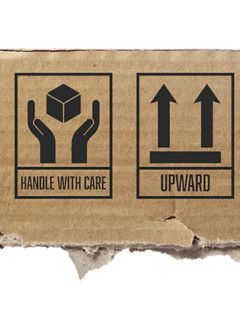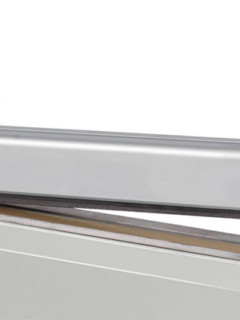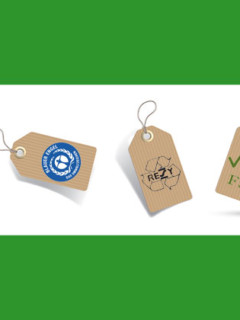Plastics offer optimal protection against dust, dirt or moisture. That is why numerous packagings are made of plastics and we constantly encounter them in everyday life, e.g. in the form of food packaging, canisters or bottles, bags or films. With a 42.5 % market share in Germany, plastic packaging such as LDPE packaging is still the bestseller among packaging materials in 2013.
Not all plastics are the same
We always talk about plastic or colloquially “plastics” when we are talking about an organic, polymeric solid. “Polymer” means “made up of many identical parts” and describes the repetitive, chain-like chemical combination of similar molecules. A bag made of plastic therefore consists of millions of intertwined chains of molecules that create an extremely close-meshed and stable network, so to speak. The “basic building block” used to create these chains determines the type of polymer and its properties. Within German packaging production, “ethene” is the star building block here with a share of over 50%. By linking them, the well-known plastic polyethylene (PE for short) is created. In Germany alone, a total of 18.5 million tonnes of PE were produced in 2015, most of which was processed into plastic products such as hoses, films and semi-finished products.
The German packaging market 2013. source: Sustainability Report 2014 of the IK Industrievereinigung Kunststoffe e.V. (PDF). Packaging production by type of plastic 2013 Source: Annual Report 2013/14 of the IK Industrievereinigung Kunststoffe e.V., p.37 (PDF)The chart shows that even within polyethylene a further distinction is made between HDPE and LDPE (often also referred to as PE-LD). LD and HD stand for low- and high-density, respectively, and are based on the different densities of the materials. Whereas LDPE weighs between 0.915 g and 0.935 g per cubic centimetre, HDPE weighs between 0.94 g and 0.97 g. The density of the polyethylene is determined by the weight of the material.
LDPE packaging: Experience in dealing with pressure
The biggest difference between LDPE and HDPE is in the production process: while HDPE is produced at moderate temperatures of (50-120 °C) and moderate pressures (approx. 1-20 bar) with the help of a catalyst in a “controlled” way, LDPE has to go through much more. Here, ethene is brought to a “radical polymerisation” in a gaseous state at a temperature of up to 300°C and a pressure of up to 3000 bar – a chain reaction that only ends when the reactive material is consumed.
The high pressure results in a high proportion of short- and long-chain branching, which prevents the polymer chains from working closely together and thus causes the lower density. LDPE therefore also has a higher light transmission, which can reach transparency in thin films. LDPE is less hard than other plastics, but has high stretchability and low-temperature impact strength as well as good sliding friction behaviour. Because of its higher ductility and mouldability, LDPE is also called soft polyethylene. PE has good electrical insulation properties and good chemical resistance to a wide range of acids, bases, oils and greases. The base material polyethylene hardly absorbs any water and the gas and water vapour permeability is lower than with other plastics. Another positive feature of this plastic is its permeability to oxygen, carbon dioxide and aromatic substances. Since the material itself is also tasteless and odourless, LDPE is particularly suitable as a packaging material.
The life cycle assessment of PE
In its “pure form”, polyethylene consists only of hydrogen and carbon. Ideally, therefore, it can burn to carbon dioxide and water vapour in waste incineration. However, depending on the area of application, certain additives are mixed into LDPE. The addition of lubricant, for example, makes the film particularly smooth, and with the help of a UV stabiliser, the film can become impermeable to UV radiation. In principle, polyethylene is considered to be more environmentally friendly than, for example, PVC or other plastics. Polyethylene contains no volatile plasticisers and is easier to recycle than other plastics. Occasionally, however, plasticisers are added, depending on the area of application. In addition, the production of polyethylene is more resource-efficient.
But: Microparticles containing polyethylene are now detectable in worrying quantities in the air, water and nature. Not all polyethylene is recycled, and it often ends up in the environment. However, the plastic is not degradable under “normal conditions” and is broken down into tiny particles over years, e.g. by solar radiation. The small PE particles thus become a real problem for the environment.
LDPE packaging: Many applications – Much choice
The LDPE base material is usually traded as granules to be remelted and processed into films. For example , rubbish bags are a very typical LDPE product. The list of other possible applications is almost unlimited. In our assortment you will find numerous different LDPE packaging.
In the bags and presentation material section you will find a large selection of bags made of LDPE film in different sizes, which can be closed by pressure seal, pressure sensitive closure, sliding closure or by welding. These are also available in the recycled variant, such as our environmentally friendly flat bag, which is made from 100% recycled LDPE. The bags are also available as protective bubble films. Due to the lower melting point at just over 100°C, they are uncomplicated to seal and thus airtight and secure.
The high stretchability and resistance to tearing also makes it possible to use LDPE films for stretching pallet loads. With additionally pre-stretched stretch film, which does not have to be stretched again compared to conventional stretch film, the film width even remains constant during use. This results in 50% less consumption and waste after unpacking and stretching is more pleasant due to the low effort required and saves 20% of your time.
An additional advantage is the “memory effect” of LDPE: During production, a certain orientation of the polymer chains can be imposed on the plastic by applying mechanical force (stretching). Abrupt cooling during the extrusion process “freezes” these tensions within the material. Shrink films and bonnets produced in this way thus have a built-in shrink force. When the film is reheated, e.g. with the help of a gas gun, the chain molecules can return to their original position: The film contracts and wraps itself “skin-tight” around the contours of the product or pallet.
More overview for you!
As you can see, (low-density) polyethylene has it all: an everyday material that is so versatile really deserves to be called an artificial fabric!
From now on you will find a new page with all LDPE packaging in our webshop, so that you can find all products made of this material easily and directly!
Further information:
- Information material of the IK Industrievereinigung Kunststoffverpackungen e.V.
- Overview of polyethylene on kunststoffe.de (trade journal for technicians and engineers in the plastics industry)
- Final report on the “Development of a test method for the practical determination of the shrinkage behaviour of shrink films”, Dipl. Ing. Jörg Loges, Institut für Distributions- und Handelslogistik (IDH), Dortmund(PDF)
- Information on the production of polyethylene, LDPE and HDPE at chemgapedia.de
- BAM Dissertation Series, Volume 53, Dipl.-Chem. Margit Weltschev (2010): Comparison of material properties of moulded materials made of high density polyethylene with the type behaviour of dangerous goods packaging.
- (Chain) polymerisation on wikipedia: http://de.wikipedia.org/wiki/Kettenpolymerisation















